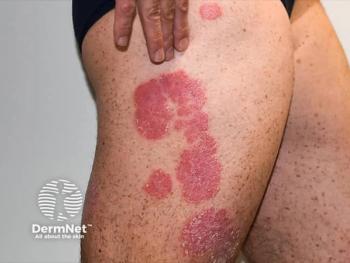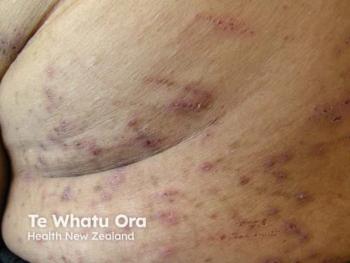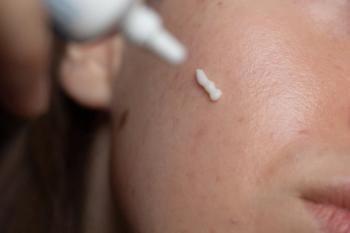
Tralokinumab Eases Joint Pain in Patients With AD
Key Takeaways
- Dupilumab, an IL-4 receptor antagonist, is effective for AD but linked to musculoskeletal adverse events, particularly arthralgia.
- IL-4 inhibition may cause T-helper cell imbalance, potentially triggering inflammatory conditions like arthritis.
Tralokinumab offers a promising alternative for patients with atopic dermatitis experiencing dupilumab-related arthralgia, achieving skin clearance and symptom relief.
For moderate to severe cases of atopic dermatitis (AD), systemic therapies are often necessary to control symptoms and prevent relapses. Dupilumab, an IL-4 receptor α antagonist that inhibits both IL-4 and IL-13 signaling, has been a significant advancement in biologic therapy for AD since its FDA approval in 2017.1 However, despite its efficacy, an emerging pattern of musculoskeletal adverse events (AEs), particularly arthralgia (joint pain), has been observed in a subset of patients.2
The Immunological Basis of Dupilumab-Associated Arthralgia
The pathophysiology behind dupilumab-associated joint pain is still under investigation. IL-4 plays a key role in maintaining the balance between T helper cell (Th) subsets, particularly Th2 and Th17 cells. Blocking IL-4, as dupilumab does, may tip this balance in favor of Th17 cells, potentially triggering inflammatory conditions such as arthritis, enthesitis, or psoriasiform dermatitis.3
Authors of the featured study suggest that “inhibiting IL-4 may imbalance T-cell populations leading to expansion of Th17 cells, which could provoke arthralgia symptoms.” This hypothesis is supported by real-world evidence showing the onset of musculoskeletal symptoms during dupilumab therapy in otherwise well-controlled AD.4
Tralokinumab: A Focused Biologic Alternative
Tralokinumab, the second FDA-approved biologic for patients with AD and the first to target and inhibit the IL-13 cytokine, may offer a viable alternative for patients who experience joint-related AEs from dupilumab. Unlike dupilumab, tralokinumab does not inhibit IL-4, potentially avoiding or minimizing the immune imbalance that may drive joint inflammation.
The case series presented by Greenberg et al evaluated 15 patients with AD who discontinued dupilumab due to arthralgia and were subsequently treated with tralokinumab.4 The results were promising: “All 15 patients achieved clear or nearly clear skin and demonstrated reductions in AD signs and symptoms.... Importantly, all patients experienced resolution of arthralgia without recurrence while on tralokinumab.”
Clinical Outcomes: Real-World Case Series Evidence
The patient cohort included individuals aged 26 to 84 years, most of whom had experienced AD for several years and previously tried multiple therapies. Prior to switching, the majority had moderate AD based on Investigator Global Assessment (IGA) scores. After transitioning to tralokinumab, all patients achieved IGA scores of 0 or 1, indicating clear or almost clear skin.
Beyond skin clearance, pruritus improved substantially: 73% of patients reported complete resolution of itch (numerical rating scale score of 0), and the remainder reported only mild symptoms. AEs were rare and limited; 1 patient reported transient burning and headache that resolved without intervention.
“In this cohort of patients, not only were the arthralgia symptoms mitigated, but the patients achieved high skin clearance and itch reduction,” trial investigator and Dermatology Times Editor in Chief Christopher Bunick, MD, PhD, said in a recent interview.
Considerations and Future Directions
Interestingly, 1 patient also experienced arthralgia on lebrikizumab, another IL-13–targeted therapy, raising questions about the nuances of its mechanism of action. It is hypothesized that lebrikizumab may exert indirect IL-4 suppression by altering IL-13 receptor availability. “This single case suggests that tralokinumab, as opposed to lebrikizumab, may potentially be the preferred alternative biologic for patients developing arthralgias on dupilumab,” the authors noted.
Although the findings are encouraging, larger prospective studies are needed to validate tralokinumab’s long-term safety and efficacy, especially in patients who experience musculoskeletal AEs from dupilumab or other biologics.
“Additional studies are also needed evaluating AD patients with biologic-induced arthralgia who switch to oral JAK inhibitors; for example, upadacitinib is FDA approved for psoriatic arthritis and may also represent an effective therapy for mitigating arthralgia while achieving optimal treatment targets for skin and itch,” Bunick said.
Conclusion
Tralokinumab appears to be a safe and effective treatment alternative for patients with moderate to severe AD who develop arthralgia while on dupilumab. With its more selective mechanism of action and favorable tolerability profile, it may help preserve disease control while mitigating uncomfortable and potentially treatment-limiting AEs.
As understanding of immune-mediated diseases evolves, personalized therapy—guided by the patient’s immunological response to specific cytokine inhibitors—will likely become the cornerstone of effective long-term AD management.
References
- Harb H, Chatila TA. Mechanisms of dupilumab. Clin Exp Allergy. 2020;50(1):5-14. doi:10.1111/cea.13491
- Kychygina A, Cassagne M, Tauber M, et al. Dupilumab-associated adverse events during treatment of allergic diseases. Clin Rev Allergy Immunol. 2022;62(3):519-533. doi:10.1007/s12016-022-08934-0
- Lasheras-Pérez MA, Palacios-Diaz RD, Pozuelo-Ruiz M, Torres-Navarro I, Botella-Estrada R, Rodriguez-Serna M. Switching from dupilumab to tralokinumab in patients with atopic dermatitis due to inefficacy or side effects. Int J Dermatol. 2024;63(1):105-107. doi:10.1111/ijd.16926
- Greenberg A, Shahriari M, Cameron M, et al. Tralokinumab as a therapeutic alternative for dupilumab-associated arthralgia in atopic dermatitis: A multi-center case series. J Clin Aesthet Dermatol. 2025;18(5):16-19.
Newsletter
Like what you’re reading? Subscribe to Dermatology Times for weekly updates on therapies, innovations, and real-world practice tips.


















